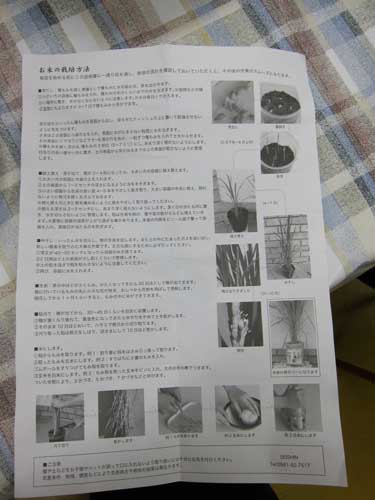
Growing rice in buckets on the sidewalk isn’t likely to put any rice farmers out of business. Still, it’s a lovely sight in Tokyo during the summer, and brings a country feeling into the hard-surfaced city.

Growing rice in buckets on the sidewalk isn’t likely to put any rice farmers out of business. Still, it’s a lovely sight in Tokyo during the summer, and brings a country feeling into the hard-surfaced city.
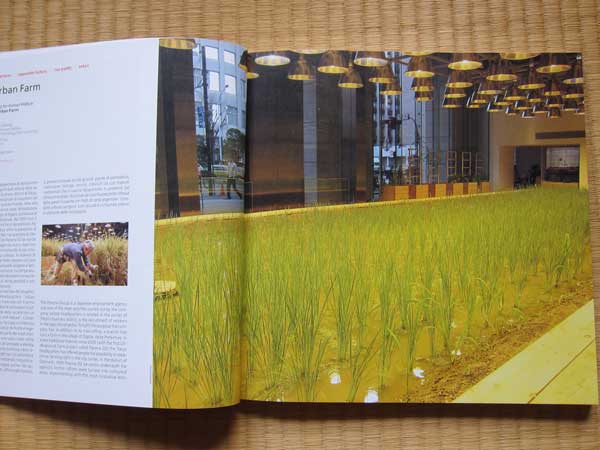
「Lotus』というイタリアの雑誌に私の東京の農園の写真が二つでました。パソナのロビーの田んぼと銀座農園の空き地の田んぼの写真が選ばれました。「Lotus』には素敵な建築のプロジェクットがたくさんのっています。四角いかたちです。もっと東京のグリーンスペースを雑誌に紹介したいです。
Lotus Editorial kindly sent me a copy of Lotus 149, titled Lotus in the Field, which explores the relations with the countryside. Lotus is a beautifully designed, Italian-English bilingual architecture quarterly from Milan.
Lotus 149 includes two of my urban agriculture photographs: one of Pasona’s corporate lobby rice field, the other an outdoor, temporary rice field in Ginza that took advantage of an empty lot between demolition and new construction.
I was happy to see that my Pasona photograph extends into a second page, and I like how the image shows a more ambivalent side of the project than the text and photos provided by the architects and corporation. Especially with the post-3.11 energy shortages after the nuke plants have been suspended, creating a show garden with grow lights looks less than utopian.
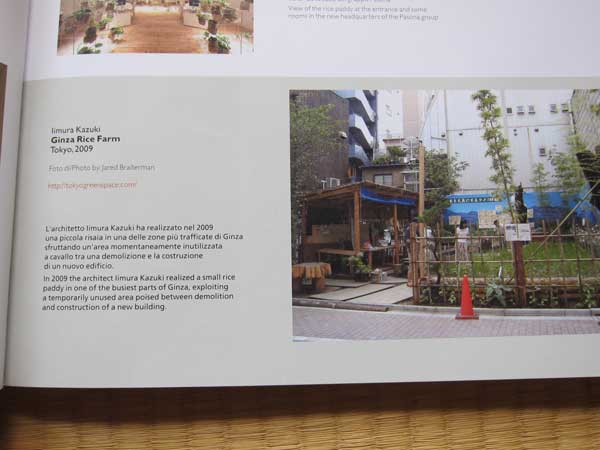
You can see the original 2009 and 2010 posts on Tokyo Green Space that inspired Lotus 149: about Pasona, and about Ginza Farm.
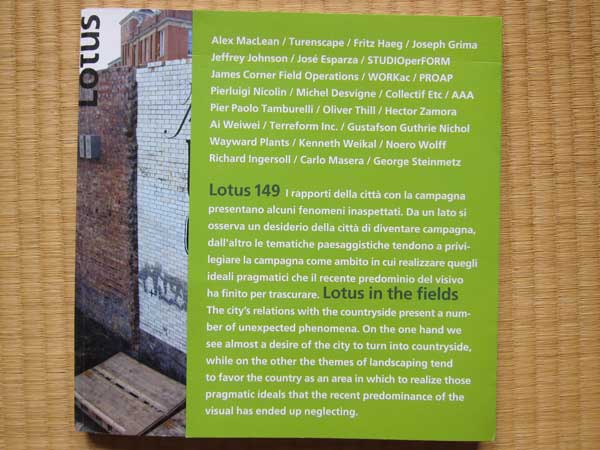

史火陶芸教室の生徒さんの一人、萩原さんがしめ飾りの作り方を教えました。材料はとても素敵だったと思います。様々なマツ、松ぼっくり、紙垂、稲穂、リボン、縄、ベリー、バラの実、乾燥した葉や花を使いました。お店で買ったしめ飾りよりずっと素敵です。萩原さんはこのブログをいつも読んでくれています。ありがとうございます。
Fellow Shiho ceramic studio student Hagiwara-san organized a new year ornament or shimekazari workshop. It was so fun to work with beautiful, fresh materials, including several types of pine needles, pine cones and woody seed husks, Shinto folded paper, rice, ribbons and ropes, berries and rose hips, even dried chocolate cosmos and other leaves.
In past years I’ve bought them from Muji or even the supermarket. It was fun how all of the hand-made shimekazaris turned out differently. Some had circular and oval bases made of twigs and bamboo, others were tied together in a bunch. I used wires to attach the mini pine cones and even a yuzu.
Hagiwara-san is also a loyal Tokyo Green Space reader. Thank you!

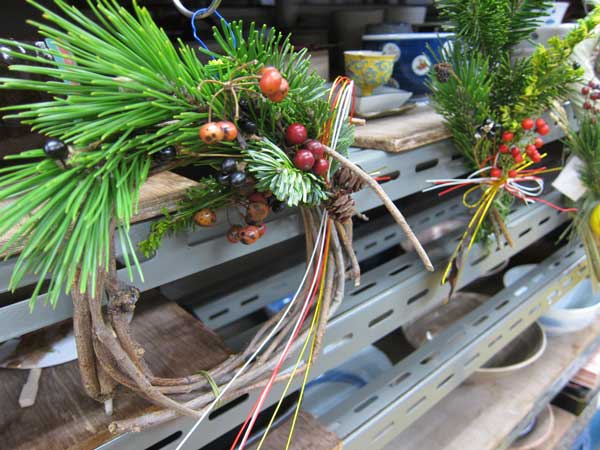
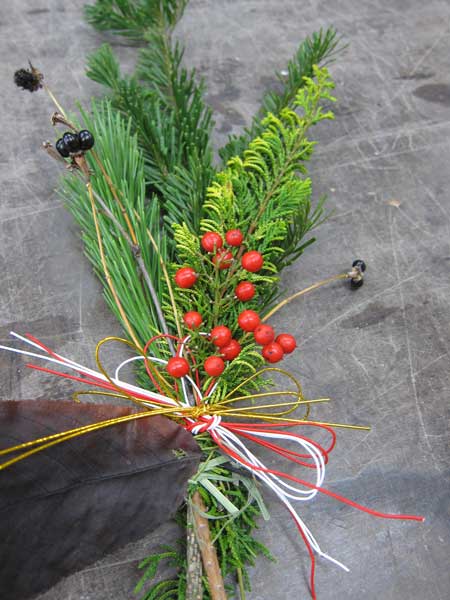
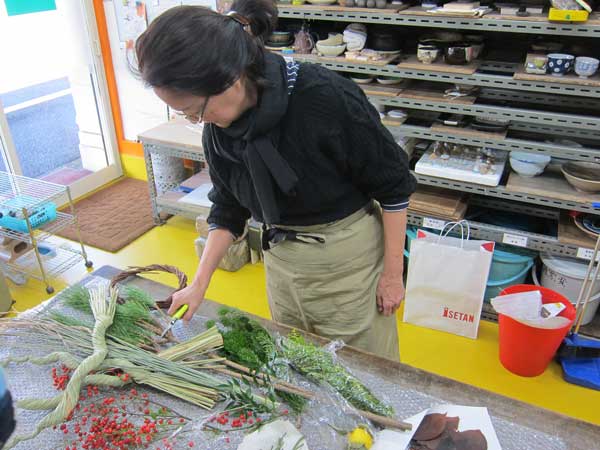
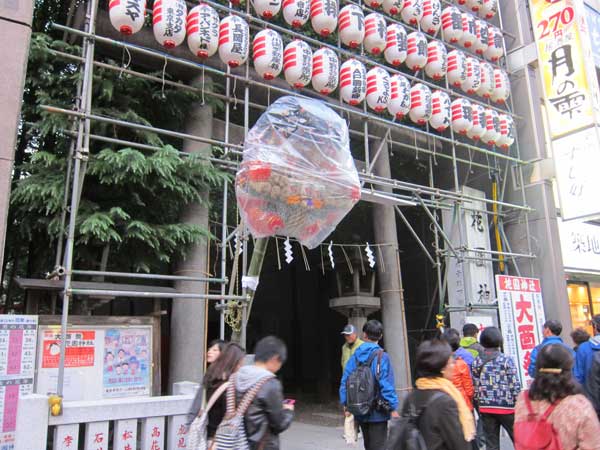
今年は酉の市が三回あります。もう熊手を買いました。同じ日に新しい仕事の契約を結びましたから、去年のよりサイズアップしました。新宿花園神社のこの祭りが大好き。たくさん水商売のオーナーが参拝にきます。でも、酉の市が三回ある年は、火事の危険が高くなると言われています。
With an entrance on Yasukuni Dori no wider than the average office building, the large Hanazono shrine in Shinjuku can easily be missed. Except in November, when the entrance is filled with lanterns and a giant rake, protected in plastic from the rain, for Tori no Ichi festival.
This festival centers around the sale of lucky rakes, made of bamboo and hot glued ornaments including rice, pine, gold coins, tai fish, and other lucky charms. One variation included all the Anpanman characters.
This year, I “sized up” from last year’s rake. The first day of the festival, I signed a new contract so I guess last year’s rake worked! I dutifully took last year’s rake back to the shrine, and added it to the pile of old rakes.
When you purchase a rake, the sellers gather around and clap wood blocks to wish you luck. I saw one rake purchased that cost 300,000 yen (yes, over US $3,000) and had to be carried by two men. Delivery is probably free when you buy such a huge one.
What makes this particular shrine fun is that all this spiritual and monetary focus caters to the Shinjuku nightlife world, as it stands in the center of Kabukicho, Golden Gai, and Ni Chome.
Because of the vagaries of the lunar year, this year there are three days this month for the festival (Nov 2, 14, and 26). There’s a superstition that when there’s three festival days, there is an increased risk of winter fires.
As fall turns to winter, I expect to hear small groups of people walking my residential neighborhood and clapping wood blocks to warn residents of the danger of fire. In the meantime, this oddly patched warning showed up at a train station. I wonder what word is underneath the English correction.
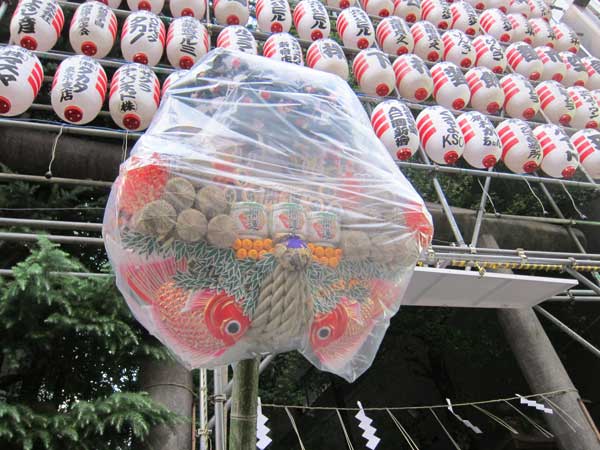
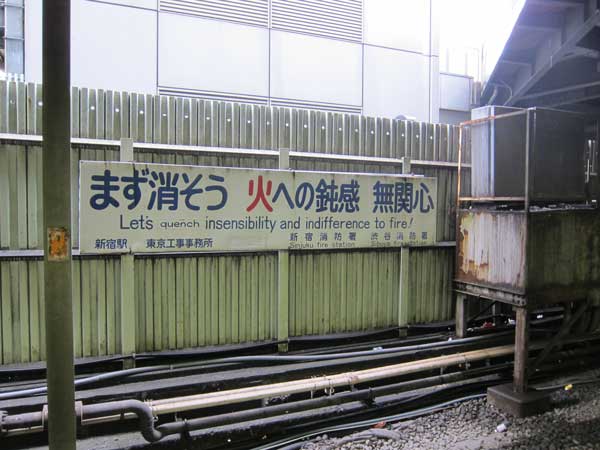

東京農業大学の鈴木先生は東京の中学校でホタルの生息地を作る予定です。毎夏、先生と中学生は群馬県に行って、ホタルを観察して勉強します。今回、私も招待されました。
ホタルにはきれいな水と暗闇が必要です。鈴木先生によると、都市の生息地には社会的なデザインも要ります。学校のとなりのお寺や退職をした方たちのセンターも参加できます。
川場村に来て、中学生たちは田んぼの草むしりをして、小さい川でカニとカエルを観察しました。都市の子供なのに、中学生たちは本当に勇気があります。
夜に、ゲンジボタルとヘイケボタルを見ました。林と田んぼのそばにはホタルがいっぱいいます。
「なかのビレジ」というホテルに泊まりました。内側は和風モダンで、外側は山の一部 みたいです。湯名な坂倉建築研究所はホテルを作りました。
川場村では、たくさんリンゴが育っています。最近、ブルーベリーも育っています。
Tokyo University of Agriculture Professor Suzuki is planning a firefly habitat at a junior high school. Each year, teachers and students from the Tokyo school visit Gunma to study fireflies. This year I was also invited.
Fireflies need clean water and darkness. According to Professor Suzuki, creating habitat in the city also requires a “social design.” The temple, cemetary, and senior center near the school are also invited to participate.
When we arrived at Kawaba-mura, the school girls weeded a rice field and played with frogs and crabs in the creek. Even though they are city kids, the students are very brave.
At night, we saw Genji fireflies and Heiki fireflies. There are a lot of fireflies on the edge between the forest and the rice field.
We stayed at a hotel called “Nakano Village” which on the inside is Japanese modern style, and on the outside the building looks like part of the hillside. It was designed by the famous Sakakura Associates.
Kawaba mura has many apple orchards, and recently they are also growing blueberries.
The trip made me think of the following:
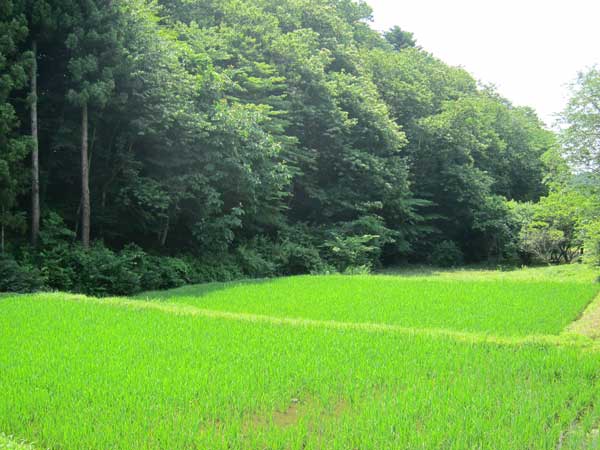


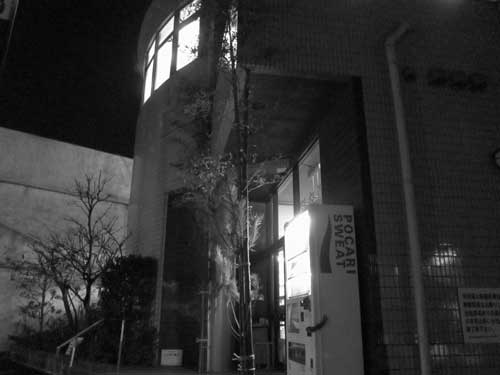
東京のお正月の時だけですが、神様を迎え入れます.
Tokyo residents and small businesses welcome the gods in temporary homes built of bamboo, pine, and plum blossoms.
I love how the best ones are hand-crafted from pine, bamboo, and plum blossoms. They are intended to be temporary homes for the Shinto gods (kami, 神様). I like the idea that you can create a temporary house for the gods to visit at new year. The three heights of the kamomastu represent heaven, humanity, and earth- in descending order. The shimekazari are smaller, with Shinto rope holding charms such as oranges, folded paper, rice straw, and ferns.
Shimekazari (標飾り) and Kadomatsu (門松) are traditional New Year’s ornaments placed on walls and on the sidewalks outside shops and homes. The city simultaneously empties of people and fills with physical connections to mountains and spirits. This year I took photos of the widest variety I could find in the areas I visit on typical days: on a car bumper, outside a sento, next to a wall of cigarette advertisements, on a busy boulevard, outside a barbershop, pachinko parlor, 24 hour convenience store, and a department store.
After the holiday, these decorations should be burned at a shrine. By mid-January, they are already a faded memory.
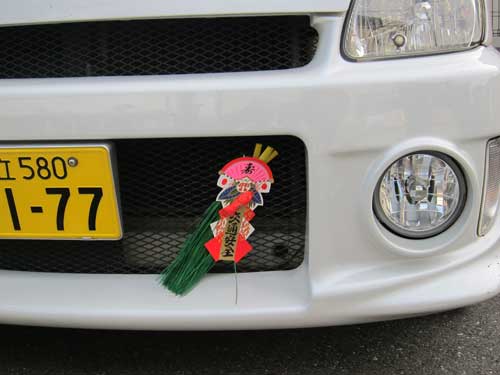
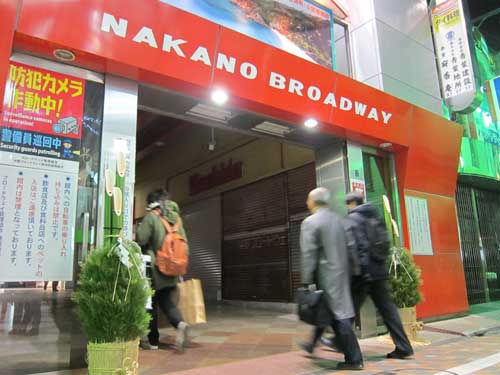

See more photos after the jump.
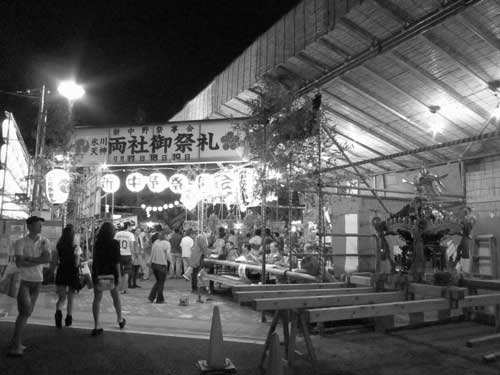
The lanterns announce that the omatsuri festival will be happening Using simple plumbers’ fixtures and scaffolding, flexible and removable frames for lighted paper lanterns are erected all over the city.
I find omatsuri incredibly charming: a public street festival evoking rice farming and harvests, organized in Tokyo around tiny local shrines, work organizations, and local associations. A friend told me that in his town, the whole town celebrates together. But in the large megalopolis of Tokyo, the intensely local nature of each celebration is very personal and social.
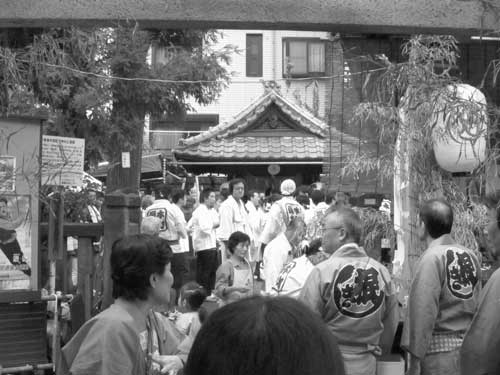
Members of my apartment building are some of the main leaders of our local shrine’s festivities, which includes children’s and adults’ parading through the streets with portable shrines, flute, drum and bell music, (Japanese) lion dancing, traditional clothes including hapi (cotton jackets), and lots of public drinking.
At the shrine, one of my neighbors offered me a free shaved ice. I hesitated to accept other offers of food or drink because I did not want to be carrying the portable shrine; I know from experience that this is best left to younger and drunker participants.
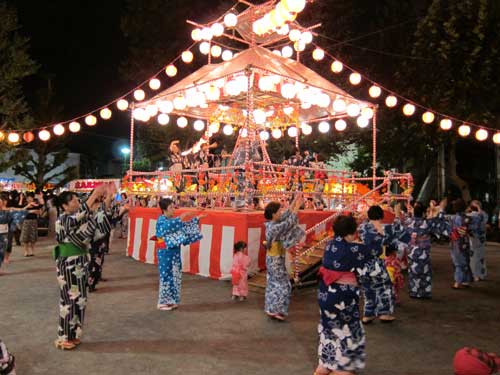
Just in the other direction, on the same weekend, a small park gets transformed into a space for dozens to do “bon” dancing around a raised platform. Mostly seniors, they dance to various traditional and regional songs, while wearing yukatas. Children and even dogs come wearing this summer kimono. Unlike the local shrine, this small park has an area for more commercial “omatsuri” games and foods, including delicious mini-cakes, the ever present chocolate banana on a stick, yakisoba, takoyaki, okonomiyaki, and more shaved ice.

I experimented this time with black-and-white photos that seem to make the event more timeless and nostalgic. It’s funny to see something very contemporary, like a child taking a cellphone photo of her chocolate banana, using this backward-seeming technology and juxtaposed with dances and music that may be centuries old. There’s something timeless about cast iron pans used over a gas grill to make the small cakes sold 12 or 40 to a bag.
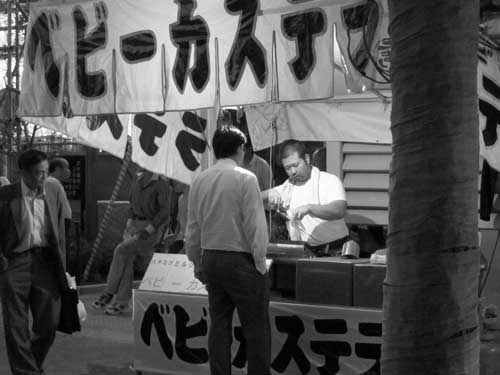
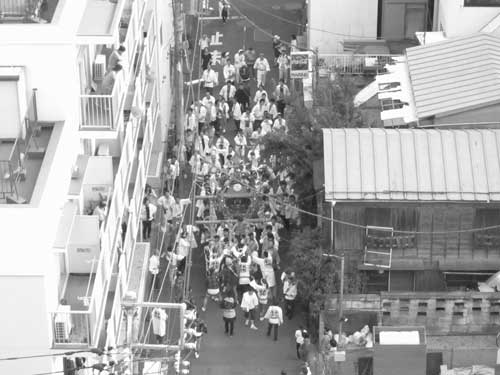
I feel a certain surge of excitement when the portable shrines enter the large boulevard or fill the small streets radiating out from it. The shrine is very heavy, and there’s a definite camaraderie formed by sharing this load.
I’ll end the post with a short video of the dancing. The drumming and bells are live, and the other music and voice from an old CD player and simple amplifier sound system.


The New York Times ran a great story about how a small town in northern Japan named Inakadate has been creating art works using colored rice as a way to attract tourists and revive a struggling economy. Creating this living art work has brought the community together and draws up to 170,000 visitors to this town of fewer than 9,000 mostly elderly residents.
Five colors of rice plotted intricately on the field yield this image of a samurai fighting a warrior monk. The cost of renting and planting the field is about US35,000 making this an affordable rural revitalization effort. Last year 170,000 visitors came to view the rice art. And each year the town tries to outdo previous efforts to continue to gain media attention and visitors.

I wonder what this sidewalk rice tastes like? Will the gardener make a special meal with it? It’s great to see how enthusiastic people are to grow the most basic Japanese food, using a recycled styrofoam box. This same gardener is also growing cherry tomatoes and ornamentals. I like the juxtaposition of street, plants, and laundry hanging to dry.

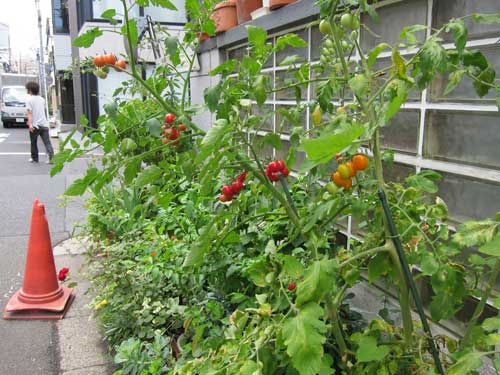
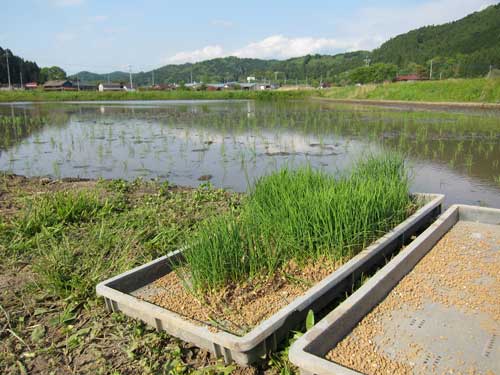
It’s always an adventure to get out of Tokyo and see rural Japan. Recently, TEDxSeeds executive producer Ito Hiromasa (伊藤 弘雅) invited me to join some of his friends on a day trip visit to an experimental “mountain cow” farm and Free Farm, which produces rice and vegetables, in Nasu, Tochigi.
We were lucky to be there on the day of rice planting, called taue (田植え). Farmers use a simple machine that inserts the seedlings into the wet rice paddy. It is amazing how symmetrical it becomes. There was something magical about seeing rice planted. Along with the small machine, two women were working very hard unloading the seedlings and making the watery mud even with a large wood instrument.

The farmers invited us for gyoza dumplings and zero food mile rice. Free Farm has a great blog that connects city people to farmers, and a fresh food delivery service (link in Japanese with lots of great photos). Another TEDxSeeds organizer, Sato Hirotsugu, was at the farm for the weekend, and he was very welcoming.

UPDATE: I posted a revised article, “Sensing Four Seasons at a Tokyo Office Building,” on Huffington Post on July 30, 2010.
Some friends and I visited Pasona’s new office last week. They are a large Japanese staffing farm that had a highly publicized basement farm in their old Otemachi headquarters. This year they moved nearby to Yaesu in their own newly built, nine story headquarters between Tokyo Station and Nihonbashi. Pasona has unveiled a much more elaborately landscaped interior and exterior.
The image above is my favorite because it highlights the interface between the futuristic farm, dependent on a variety of grow lights including LEDs, and the urban environment outside. I am certain that the indoor vegetables will give them the most attention again, but actually I believe the exterior landscaping is more inspiring and impactful.

Below is a brief tour of interior and exterior. After the photo tour, I will suggest some metrics for judging the success of this very visible corporate monument to urban nature.
Glowing all the way across the wide downtown street even in daylight, a spectacular rice paddy with dozens of strong lights occupies the main lobby entrance of the building. The entrance doors are flanked on the outside by beautiful apple trees in giant rusted steel planters.

Almost the entire first floor of the building is devoted to the spectacle of vegetables planting, growing, and ripening under powerful grow lights: rice, tomatoes, melons, corn, eggplants, herbs, and lettuce. A large cafe features wood posts hung at angles and supporting canvas bags with soil and corn. One wall has a series of metal cases with purple lights and tiny fans that have a very “next century” feel.
There is also a room with racks and racks of lettuce, and a field of giant sunflowers. And everywhere vegetables and seedlings are arranged in attractive vignettes. Elsewhere, tomatos hang from the cut-outs in the ceiling. (Click to enlarge the photos below).




What I think works are the following:
But I also have to point out where the vision falls short.
While the indoor farm will generate the most attention for Pasona, I think that the exterior landscaping is more impressive and ultimately more interesting for urban habitat creation and the integration of nature with work space. Two thirds of the building front and at least one side have been carefully planted on handsome screened balconies to produce four seasons of color. Included are citrus trees, wisteria vines, Japanese maple, blueberries, and flowering vines like clematis. Although the plants are small now, it is easy to imagine the exterior becoming a unique vertical forest and colorful garden over the next years.
The exterior vertical landscaping has 200 species of plants, and many trees that lose their leaves in the winter. The idea is that the plant mass will reduce carbon emissions, summer shade will keep the building cooler, and winter bare branches will allow more direct light during the cold season. While the public is not invited to the upper floors, it appears that the exterior plants are all on balconies that are either accessible or viewable from inside the offices. Click below to see posters that explain the exterior landscape and the designers who worked on this project, and how the exterior garden appears from the sidewalk below.



I am looking forward to watching the exterior of the building grow into its potential. And I am eager to hear how the office workers feel about the outdoor plants that are so close to their interior work spaces.
I’ll end this post with a dandelion weed I spotted on the edge of the rice field. It is this type of unplanned feature that makes natural landscapes so enchanting.
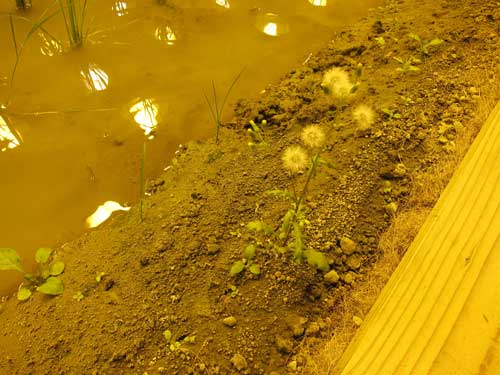

Woman’s Day published a “Magnificent Urban Gardens” feature for Earth Day. The ten photos include two from Tokyo Green Space: Ginza Farm’s rice field and the sidewalk pansies photo that is the project icon. I am amazed that these photos are in the context of famous and not so famous world city gardens, including Patric Blanc’s London Athenaeum Hotel, NYC’s High Line, Chicago’s City Hall, and a cool basil wall next to a NYC pizza oven.
I love how the focus is on beauty as much as environmental benefit.
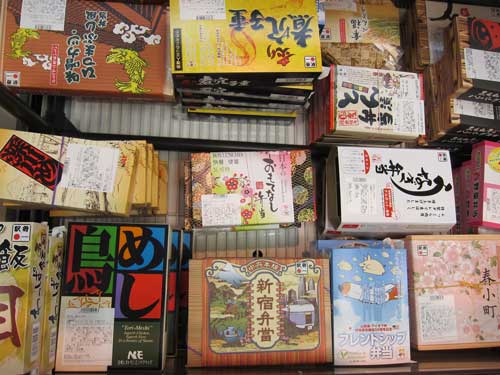
Last weekend I went to Suwa in Nagano with Kobayashi sensei of Sinajina for the famous, once every six years onbashira festival.
Over two months, the residents of Suwa select enormous trees growing on top of the mountain ridge, cut them and transport them down the hills by dragging them with rope, race down a hill sitting on the logs, and eventually lift them up at several important shrines (while people stand on top of them, I guess, to make it more difficult, heavy and dangerous).
Onbashira is a very pleasant mix of animism, forestry and virility. More on the ceremony later.
But, first, the first joy of taking any trip in Japan is buying a bento at the station. There is an incredible variety, priced from about 500 yen to 1,500 yen. Each comes beautifully wrapped in a box, with fantastic graphic design. You can see some cool typography, artistic mountains and trains, a space shuttle, a pokemon, and cherry blossoms.
I chose the spring special, decorated with sakura petals. Inside I was delighted to find over twenty different foods, including takenoko (bamboo shoots).

Even more remarkable, my box came with a photo and description of the organic rice farmers.
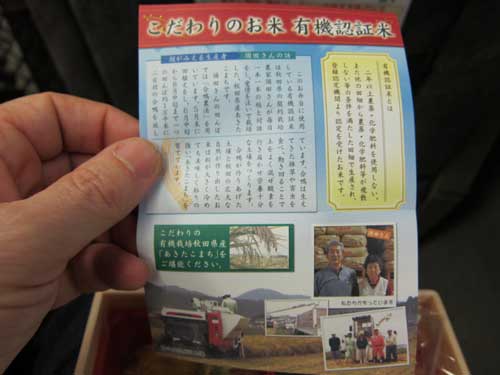
And lastly here’s the purple-striped beauty that got us to the Suwa lake in just two hours from Shinjuku.

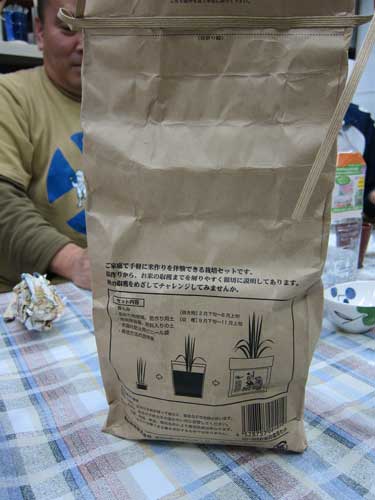
My father in law received a kit to grow rice, complete with detailed instructions in this attractive bag.
Anyone who lives in Japan knows Donki, the abbreviation for Don Quixote, a chain of crowded shops full of the oddest merchandise, from electronics to clothes to food. Known for low prices, Donki is the inverse of a posh department store.
I was surprised to see that Donki (well, some of the stores) now sells grow-you-own-rice in a kit. It’s exciting to see an interest in growing your own food spreading to such a popular urban store. Have you seen other kits that encourage first-time city farmers?

